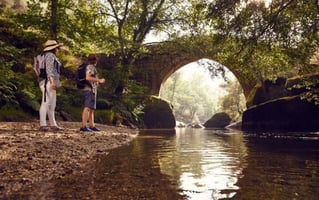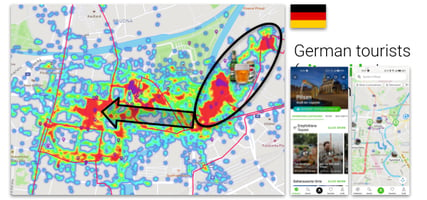Tourism is responsible for about 8% of the world’s carbon emissions, with activities like plane...
How audio guides can help optimize public space management in tourist destinations
Managing public spaces in hotspot tourist destinations is a complex challenge due to the constant influx of visitors and varying needs. One effective solution to dispersing crowds is the implementation of digital audio guides, which not only improve visitors’ engagement and inspire them to visit lesser-known places but also provide valuable data for public space management.
These digital guides offer tourists detailed information without needing physical guides, making it easier to control crowds, reduce large tourist groups, and bring more sustainable tourism. Furthermore, digital audio guides can collect insights into visitor behavior, preferences, and movement patterns, aiding in better space utilization.
Read more to find out how audio guides, or better said audio guide platforms and apps, can be an important tool in managing public spaces and enhancing visitors’ satisfaction.

Digital audio guides - What they are and how they work?
Audio guides are digital tools that offer narrated information to visitors, enhancing their understanding of tourist destinations. They work by providing audio content through various platforms such as smartphones, dedicated devices, or even through web-based applications.
Types of audio guides
- App-based audio guides: These are accessed through mobile apps, allowing users to download the guide onto their personal devices such as the SmartGuide travel guide app.
- Device-based audio guides: These guides typically include a handheld device with pre-loaded content. Museums and historical sites often use this type as it has been the major widespread guiding technology since before the digital age.
Let's focus on the digital guides and travel guide platforms and their benefits compared to their device-based counterparts.
What are the benefits of digital audio guides?
Digital audio guides serve as valuable tools for both tourists and destination managers in the following ways:
For tourists:
- Flexibility: Visitors can explore at their own pace with their own digital devices, without being tied to group schedules or device-based guide rentals. This allows them to visit during off-peak hours, avoiding crowds.
- Engagement: Modern digital audio guides can include interactive elements such as augmented reality, videos, photos, custom quizzes, and games, making the visit more engaging.
- Multi-lingual features: Many digital audio guides support multiple languages (e.g. thanks to built-in auto-translation capabilities), making destinations and attractions accessible to a broader audience.
- Personalization: A digital audio guide (SmartGuide being the world's first digital guide platform to offer this feature) is also capable of providing personalized recommendations based on visitors' preferences and past behaviors. This ensures that each visitor has a unique and tailored experience.
Personalized recommendations in SmartGuide travel guide app
For destination managers:
- Better resource allocation: By analyzing visitor patterns collected through digital audio guides, managers can spot significant trends and allocate resources more efficiently.
- Improved maintenance scheduling and infrastructure planning: Insights from digital audio guides help in planning maintenance and infrastructure upgrades so that facilities meet visitor needs.
- Advanced marketing strategies: Data on high-traffic areas and movement patterns can inform targeted marketing campaigns, attracting more visitors to (or out of) those spots.
- Increased visitor satisfaction and repeat visits: By offering a sophisticated and personalized experience, digital audio guides can boost visitor involvement and encourage repeat visits. Furthermore, positive feedback and recommendations from visitors act as a powerful channel for word-of-mouth marketing, spreading enthusiasm and endorsements that draw new visitors and boost the destination's appeal.
- Sustainable tourism: Self-guided tours and digital guides encourage less congested and more eco-friendly travel practices. By distributing tourists more evenly across different attractions and promoting visits during off-peak times, these digital tools help reduce the strain on popular sites.

How do digital audio guides collect visitor data?
Digital audio guides such as the SmartGuide travel guide platform and app gather a variety of anonymized user data for destination management (the anonymization is inherently enforced by the GDPR-compatibility of the app platform hosting the digital guide apps, such as Google Play Store or App Store from which the app usage data is sourced). This includes tracking visitor counts, identifying popular routes, and measuring the time spent at various locations.
By using GPS tracking, digital guide platforms can monitor visitor movements within a site, creating detailed maps of foot traffic patterns. NFC tags and especially QR codes serve as critical data acquisition points, strategically placed at key locations to capture engagement metrics.
Visitors interact with these tags and codes to access specific content, providing additional insights into their preferences and behaviors. These technologies go beyond simplifying the acquisition process; they facilitate the analysis of engagement data to pinpoint the most successful marketing channels and those needing improvement. By interpreting these metrics, destinations, and attractions can refine their promotional strategies to increase visibility and boost user engagement with the app.
Leveraging data analytics for public space management
Digital audio guide platforms such as SmartGuide offer detailed data dashboards and analytics tools that provide destinations and attractions with valuable insights into visitor behavior. These dashboards collect quantitative data on various aspects such as visitor origins, demographics, language preferences, and favored sites. By using these tools, destinations can understand the current tourist dynamics and make informed decisions. For instance, understanding peak visiting times and underutilized areas helps in planning resource allocation and visitor management strategies.
Visualizations like GPS heatmaps play a vital role in analyzing visitor flow and identifying congestion points. Heatmaps vividly display where and when visitors engage most actively with a destination, offering qualitative analysis of visitor behavior. They reveal the effectiveness of specific tours in distributing visitors away from crowded spots, show seasonal variations in visitor interest, and illustrate how different nationalities explore a destination. This dual approach—combining quantitative and qualitative data—provides a detailed picture of tourist behaviors, trends, peak visiting times, underutilized areas, and much more.
The data insights gained from these tools allow destinations to manage tourist distribution and plan future content strategically. For example, if a particular tour successfully encourages visitors to explore beyond overpopulated attractions, similar strategies can be replicated or expanded. Additionally, heatmap analysis can indicate which areas might benefit from additional content or guidance in alternative languages to attract a broader audience. This targeted approach amplifies visitor participation by diversifying their options and promotes sustainable and balanced exploration of a destination's offerings.

SmartGuide's data analytics - Dashboards and GPS heatmaps
Effective traffic and security management in tourism with data analytics
Using data insights to improve traffic flow and reduce congestion is crucial for enhancing public space management. Furthermore, anonymized visitor tracking behavior can boost security and emergency response, enabling authorities to respond promptly to incidents related to mass tourism and manage crowds efficiently. Personalizing interactions based on visitor data leads to higher satisfaction levels, thanks to tailored recommendations and information, distributing visitors more evenly and making each journey more enjoyable.
Case study - Redistributing tourist footfall in Rome
In 2023, SmartGuide launched new walking and bike tours in Rome, Italy, targeted at the city's less-visited outskirts. This approach aimed to alleviate the concentration of tourists from the central areas, esp. Forum Romanm and Colosseum, which had been the main focus of tourists in the destination.
By offering personalized recommendations and fresh tour content, SmartGuide successfully attracted tourists to explore Rome's quieter outer districts. This initiative not only reduced the density of visitors in the central landmarks but also provided travelers with an opportunity to discover different parts of the city, leading to a more balanced distribution of foot traffic and improved satisfaction among visitors.

Dedicated walking and bike tours in the SmartGuide app spread visitors to the less popular areas way beyond the inner Rome city
Integrating digital audio guides into public space management - Common challenges and practical solutions
Integrating digital audio guides into public space management often presents several challenges. One common issue is ensuring the technology is compatible with existing infrastructure and is accessible to all visitors. Another challenge is managing the cost of implementation, including hardware, software, and ongoing maintenance. Additionally, language barriers can pose problems, as audio guides need to cater to a diverse audience. Internet connectivity can also be an issue, particularly in areas with poor network coverage.
Utilizing platforms like SmartGuide can serve as a practical solution to these challenges, offering a flexible and scalable technology that easily integrates with existing infrastructure, addressing compatibility issues. Furthermore, the creation of digital guides on SmartGuide is free in a self-service mode, and quick with its user-friendly AI-powered content management system (can be managed within a few hours). This helps manage costs while providing high-quality guides.

Digital guide creation on SmartGuide's content management system
To tackle language barriers, SmartGuide provides multilingual content support, ensuring inclusivity and catering to a diverse audience. Regular updates and maintenance are essential to keep the system running smoothly and SmartGuide handles all these tasks, relieving guide creators from technical worries and expenses. Additionally, to address internet connectivity issues, this travel guide platform and app offer offline access, making it reliable even in areas with poor network coverage.
Engaging stakeholders and providing adequate training are also significant components of successful implementation. Stakeholders, including local authorities, business owners, and community members, should be involved in the planning of the experience and the decision-making process so that their needs and concerns are addressed. Training programs for visitors-facing staff and volunteers will help them use proficiently and manage the audio guide system for its long-term success.
Ready to utilize data analytics for better public space management?
Digital audio guides such as SmartGuide offer numerous benefits for public space management, including increased visitor engagement, multilingual guide content support to address wide audiences, and reduced reliance on physical signage. Therefore, destination managers are encouraged to adopt these guides to modernize their operations. Data-driven decisions are extremely helpful as they highlight the channels needed for impactful space management, providing an excellent approach to managing public spaces.
Would you like to learn more about how SmartGuide could aid public space and visitor management in your destination too?
.png?width=300&height=69&name=Logo%20SmartGuide%20horizontal%20(1).png)



